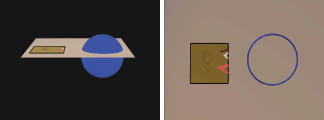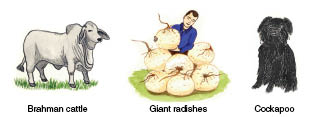Lesson 7
HOW
DID GOD CREATE MAN?
 In previous lessons we have explored the nature of God
and the nature
of man as created in God's image. We have seen a model of why God would
create man and we have seen that there is a logical reason for our
existence. The next question is a relatively unimportant one as far as
our basic theme is concerned. This is because the existence of God is
not dependent upon how He has accomplished His will. Let us examine the
broader and perhaps more vital question of God's creative technique in
general.
In previous lessons we have explored the nature of God
and the nature
of man as created in God's image. We have seen a model of why God would
create man and we have seen that there is a logical reason for our
existence. The next question is a relatively unimportant one as far as
our basic theme is concerned. This is because the existence of God is
not dependent upon how He has accomplished His will. Let us examine the
broader and perhaps more vital question of God's creative technique in
general.
 The Hebrew concept of creation
involves two different modes or means of
bringing things into existence. One of these is the process of
miraculous creation and is along the lines we discussed before. In an
earlier lesson we saw that to the man in Flatland it seemed that matter
was created from nothing when the sphere touched the plane of Flatland.
This process of creating from nothing is the concept normally indicated
by the Hebrew word bara. This is the word used in Genesis 1:1 when the
Bible says, "In the beginning God created the heaven and the earth."
The word bara is used 42
times in the Old Testament and in every case
the usage is in reference to something God does--never in reference to
something man does. The Jewish Publication Society says, "The Hebrew
bara is used in the Bible
exclusively of divine creativity. It
signifies that the product is absolutely novel and unexampled, depends
solely upon God for its coming into existence, and is beyond the human
capacity to reproduce" (Nahum M. Sarna, The JPS Torah Commentary:
Genesis [Philadelphia: The Jewish Publication Society, 1989],
page 5).
The Hebrew concept of creation
involves two different modes or means of
bringing things into existence. One of these is the process of
miraculous creation and is along the lines we discussed before. In an
earlier lesson we saw that to the man in Flatland it seemed that matter
was created from nothing when the sphere touched the plane of Flatland.
This process of creating from nothing is the concept normally indicated
by the Hebrew word bara. This is the word used in Genesis 1:1 when the
Bible says, "In the beginning God created the heaven and the earth."
The word bara is used 42
times in the Old Testament and in every case
the usage is in reference to something God does--never in reference to
something man does. The Jewish Publication Society says, "The Hebrew
bara is used in the Bible
exclusively of divine creativity. It
signifies that the product is absolutely novel and unexampled, depends
solely upon God for its coming into existence, and is beyond the human
capacity to reproduce" (Nahum M. Sarna, The JPS Torah Commentary:
Genesis [Philadelphia: The Jewish Publication Society, 1989],
page 5).
As a contrast to this concept of creation, we have what I will call
indirect making. This concept is conveyed in Hebrew by the word asah
and implies that something came into existence, not by a miraculous
process from nothing, but rather was formed or shaped from something
that already existed. If you are sitting in a building as you read
this, God did not miraculously blast that building into existence from
nothing. This is not to say that God had no role in the construction of
the building because He certainly produced the calcium carbonate,
silicon dioxide, and other chemicals that formed the concrete, glass,
and the like. He also created man to build it. The point is that there
are many things that come, have come, and will come into existence
without God miraculously producing them.
In Genesis 1 the word bara is
used in verses 1, 21, and 27. Things like
time, space, matter/energy, life, and man's soul seem to be the objects
of this description. In the other verses, it would seem that we are
being told that the process of God is one of making, molding, forming,
and/or shaping things that have already been created. Some may object
to this super-literal interpretation of bara and asah by responding
that there are exceptions to the usages I have described. Such a
criticism is valid. In most manuscripts Genesis 1:26 says God made
(asah) man in His image, and
in verse 27 we are told God created (bara)
man in His own image. This might suggest those terms bara and asah are
interchangeable. It might seem to suggest that the literalness of the
kind that we are describing cannot be supported.
The fact of the matter is that they are two different words and they do
not ordinarily mean the same thing, and such cases frequently occur in
the Hebrew language. We answer such problems by the context and by
careful consideration of what the author is attempting to convey. You
will notice that verse 26 is a communication between the persons of the
Godhead. The exchange is between God the Father, the Holy Spirit, and
Jesus Christ. (See Genesis 1:2; John 1:1; Colossians 1:16-18.) For the
Godhead, the creation of man was not a miracle. Unlike the man in the
Flatland story who could not understand the appearance of the circle in
Flatland, the sphere had no trouble understanding how the circle was
produced. It was no miracle to the sphere. To us human beings the
creation of man is miraculous, but it was not beyond God’s
understanding.
In verse 27 the discussion is in reference to man, explained in man's
dimension for man to understand. This is a miracle because the process
is outside of man's capacity to duplicate or even understand. It is
appropriate that asah was
used in verse 26 and bara was
used in verse
27. The attempts of liberal theologians to compromise the literalness
of language and remove any specific meaning is an unfortunate
compromise and completely unnecessary.
The interesting thing about man's creation is that there are two
different aspects of man that are described in the Bible, and they are
described as having been produced in two different ways. In Genesis
1:27 we see that man is created (bara)
in God’s image. We saw in Lesson
5 that this description refers to man's soul--his spiritual makeup. In
Genesis 2:7 we read, "And the LORD God formed (yatsar) man of the dust
of the ground, and breathed into his nostrils the breath of life; and
man became a living soul." Obviously, this is in reference to man’s
body--his physical makeup. Similar language is used in Genesis 2 to
describe the animals. God made man’s body from the materials that make
up the ground, and we are told in other biblical references that our
bodies will return to the ground from which those materials came. Man’s
spiritual makeup is a miraculous act of God. God created (bara) man’s
soul and that soul is eternal in nature.
How does evolution fit into this discussion? Obviously man's spiritual
makeup is not subject to physical laws, because the soul is not
physical. Whatever application evolution might have in the discussion
of man would have to be understood as dealing only with man's physical
makeup. Perhaps we, first of all, need to define what the word
evolution means. Evolution refers to an unfolding type of change. It is
not a dirty word or an evil concept. Evolution is a fact. Things do
change! You are evolving from an infant to a mature adult. Your city is
evolving in many ways. Even in a biological sense things do evolve. To
the right are three pictures of newly evolved forms of life.
In recent years various authors have attempted to put adjectives in
front of the word evolution to specialize their understandings of
different kinds of evolution. Macro- and micro-evolution are sometimes
used to restrict what type of change the author believes has occurred.
These are questions related to various theories of how the world came
to be. Those who believe in naturalism wish to suggest that the kinds
of change in the pictures above have taken place in unlimited ways and
that all of life can be explained by natural processes in which God had
no role. Those who believe that God is involved in the creation feel
there are limits to what chance can do, and would limit the degree to
which evolution occurs. This is a changing field, and will continue to
be modified and debated as more evidence and data becomes available.
We should also mention that in addition to the definition of evolution,
the word species and the word kind need to be carefully understood.
Most biology books will define a species as a group of plants or
animals that can interbreed and produce fertile offspring. The radishes
pictured on the previous page cannot interbreed with their
great-great-great-great-great-grandradish and produce fertile offspring
so it is a new species. Many insects can undergo similar evolutionary
changes, much to the frustration of fruit growers and farmers. These
new forms, however, are not new kinds. The biblical word kind which is
the Hebrew min is a very broad word. First Corinthians 15:39 is a good
place to see this distinction. Paul says in the passage that there are
four kinds of flesh: "the flesh of man," "the flesh of beasts"
(mammals), "the flesh of fish," and "the flesh of birds." This is the
same set of biological groups used in the creation account of Genesis 1
and also in the flood account of Genesis 6. The terms are very broad.
He does not say the flesh of bass, the flesh of crappie, the flesh of
perch, the flesh of striper, etc. He says the flesh of fish, which
would allow evolutionary change between various species of fish to
produce the diversity we see in today's world. None of the varieties in
the picture were known on the earth 200 years ago. The question is not
whether or not things change, the question is whether life and man are
products of blind chance or whether they are a product of God’s design.

 In man's case it is obvious
that change has taken place. If Eve is in
fact the mother of all living, as Genesis 3 says and as genetic
research confirms, all races of men on the earth must be her
descendents. The fact that all mankind is one species and has not
mutated so that there are multiple species of mankind is a supporting
evidence of our common origin. Black men, white men, orientals,
Polynesians, and the like all come from mother Eve. That means that Eve
must have carried the genetic potential to produce all these races. As
people migrated to equatorial areas of the earth, the possession of
dark skin, black eyes, and a variety of other characteristics
associated with black races offered advantages to survival in the
climatic conditions present. Migrations to northern latitudes favored
light skin, blue eyes, blonde features, and a variety of other
characteristics which favored survival in colder conditions. Once
again, this is evolution. God has made (asah) the races so that
survival can be possible on a changing earth.
In man's case it is obvious
that change has taken place. If Eve is in
fact the mother of all living, as Genesis 3 says and as genetic
research confirms, all races of men on the earth must be her
descendents. The fact that all mankind is one species and has not
mutated so that there are multiple species of mankind is a supporting
evidence of our common origin. Black men, white men, orientals,
Polynesians, and the like all come from mother Eve. That means that Eve
must have carried the genetic potential to produce all these races. As
people migrated to equatorial areas of the earth, the possession of
dark skin, black eyes, and a variety of other characteristics
associated with black races offered advantages to survival in the
climatic conditions present. Migrations to northern latitudes favored
light skin, blue eyes, blonde features, and a variety of other
characteristics which favored survival in colder conditions. Once
again, this is evolution. God has made (asah) the races so that
survival can be possible on a changing earth.
How much change like this can occur? To what extent has man changed?
There are those who suggest that such change can progress to such an
extent that our ancestry can mechanically be traced back to an
accidentally produced single-celled organism. We will explore that
suggestion in later lessons. Some would agree with that assessment, but
would suggest that God used or controlled the process. This
understanding is called theistic or mitigated evolution. Some would say
that God created Adam and Eve as we are today and  that the changes that
have taken place have only been within the family of man. There are
other views ranging from creation by aliens to a denial of any change
at all.
that the changes that
have taken place have only been within the family of man. There are
other views ranging from creation by aliens to a denial of any change
at all.
 What do you think? We are not going to embark on an
anthropological
debate in this lesson. To do so would require reprinting the lesson
every week because new discoveries are made at rapid rates. The
important thing to realize is that what separates man from other living
things is not his body or his chemistry--it is his spiritual makeup.
Can
you visualize how a spiritual creation is accomplished? Of course not,
because it is not a part of our three-dimensional world. Can you
visualize how God could have made man’s body? Of course you can,
because our bodies are three dimensional and operate in familiar
conditions. One explanation of man's being made is seen in the
following chart (below left).
What do you think? We are not going to embark on an
anthropological
debate in this lesson. To do so would require reprinting the lesson
every week because new discoveries are made at rapid rates. The
important thing to realize is that what separates man from other living
things is not his body or his chemistry--it is his spiritual makeup.
Can
you visualize how a spiritual creation is accomplished? Of course not,
because it is not a part of our three-dimensional world. Can you
visualize how God could have made man’s body? Of course you can,
because our bodies are three dimensional and operate in familiar
conditions. One explanation of man's being made is seen in the
following chart (below left).
What are the weaknesses in such a model? There are many problems in
this physical hypothesis. Evidence is fragmentary at best. The physical
definition of  man is very ambiguous so that
most anthropologists have
difficulty deciding whether erectness, brain size, tool use, or
cultural characteristics should be the dominant concerns. Soft tissue
is not ordinarily preserved as a fossil, so actual appearance is
difficult to determine. Dating methods are based on assumptions that
are increasingly dubious, and sampling and analysis techniques are
prone to error. The greatest weakness of such a model is that it does
not really deal with what separates man from other living things--man's
spiritual makeup.
man is very ambiguous so that
most anthropologists have
difficulty deciding whether erectness, brain size, tool use, or
cultural characteristics should be the dominant concerns. Soft tissue
is not ordinarily preserved as a fossil, so actual appearance is
difficult to determine. Dating methods are based on assumptions that
are increasingly dubious, and sampling and analysis techniques are
prone to error. The greatest weakness of such a model is that it does
not really deal with what separates man from other living things--man's
spiritual makeup.
 We have seen that God created man in His image and made
man's body of
the dust of the earth. What was this first man like? Was he a caveman?
What is a caveman? It is a man who lives in a cave! If you can find
someone who is willing to live in a cave, you can see a caveman today!
This does not mean that the first man (Adam) and the first woman (Eve)
were
We have seen that God created man in His image and made
man's body of
the dust of the earth. What was this first man like? Was he a caveman?
What is a caveman? It is a man who lives in a cave! If you can find
someone who is willing to live in a cave, you can see a caveman today!
This does not mean that the first man (Adam) and the first woman (Eve)
were  stupid! Paintings in caves like
the one below indicate great skill
and intelligence by the artist that drew them. It is true that these
first people had little knowledge. There were no books, schools, or
television to convey the knowledge and discovery of others, so all
learning was accomplished by those first people themselves. What these
ancient people were able to do was incredible. How rapidly they
developed in their ability to control their environment is remarkable.
Anyone who has seen the remains of the ancient Inca, Mayan, Chinese, or
Egyptian cultures has to be impressed with their ability and
intelligence!
stupid! Paintings in caves like
the one below indicate great skill
and intelligence by the artist that drew them. It is true that these
first people had little knowledge. There were no books, schools, or
television to convey the knowledge and discovery of others, so all
learning was accomplished by those first people themselves. What these
ancient people were able to do was incredible. How rapidly they
developed in their ability to control their environment is remarkable.
Anyone who has seen the remains of the ancient Inca, Mayan, Chinese, or
Egyptian cultures has to be impressed with their ability and
intelligence!
As man migrated from the Fertile Crescent area bounded by the rivers
described in Genesis 3, he found himself in new environments with new
challenges and problems. His body adapted to new climates and he
modified his environment to fit his needs. Ancient peoples built
irrigation systems, constructed all kinds of boats, made floating
gardens, and built observatories to measure the passage of seasons.
This scenario is consistent with the descriptions in the Bible and with
all available scientific evidence.
When we cut through tradition and bad science, we find that the
biblical account is not a fairy tale full of myths. We do not have all
the answers about everything God did to make us the unique beings that
we are, but what we know is logical and consistent with the Bible.
© 2009, John N. Clayton
Lesson 7 Questions
Return to the Main
Page
for the
Intermediate Correspondence Course.
11/2/2009
 In previous lessons we have explored the nature of God
and the nature
of man as created in God's image. We have seen a model of why God would
create man and we have seen that there is a logical reason for our
existence. The next question is a relatively unimportant one as far as
our basic theme is concerned. This is because the existence of God is
not dependent upon how He has accomplished His will. Let us examine the
broader and perhaps more vital question of God's creative technique in
general.
In previous lessons we have explored the nature of God
and the nature
of man as created in God's image. We have seen a model of why God would
create man and we have seen that there is a logical reason for our
existence. The next question is a relatively unimportant one as far as
our basic theme is concerned. This is because the existence of God is
not dependent upon how He has accomplished His will. Let us examine the
broader and perhaps more vital question of God's creative technique in
general. The Hebrew concept of creation
involves two different modes or means of
bringing things into existence. One of these is the process of
miraculous creation and is along the lines we discussed before. In an
earlier lesson we saw that to the man in Flatland it seemed that matter
was created from nothing when the sphere touched the plane of Flatland.
This process of creating from nothing is the concept normally indicated
by the Hebrew word bara. This is the word used in Genesis 1:1 when the
Bible says, "In the beginning God created the heaven and the earth."
The word bara is used 42
times in the Old Testament and in every case
the usage is in reference to something God does--never in reference to
something man does. The Jewish Publication Society says, "The Hebrew
bara is used in the Bible
exclusively of divine creativity. It
signifies that the product is absolutely novel and unexampled, depends
solely upon God for its coming into existence, and is beyond the human
capacity to reproduce" (Nahum M. Sarna, The JPS Torah Commentary:
Genesis [Philadelphia: The Jewish Publication Society, 1989],
page 5).
The Hebrew concept of creation
involves two different modes or means of
bringing things into existence. One of these is the process of
miraculous creation and is along the lines we discussed before. In an
earlier lesson we saw that to the man in Flatland it seemed that matter
was created from nothing when the sphere touched the plane of Flatland.
This process of creating from nothing is the concept normally indicated
by the Hebrew word bara. This is the word used in Genesis 1:1 when the
Bible says, "In the beginning God created the heaven and the earth."
The word bara is used 42
times in the Old Testament and in every case
the usage is in reference to something God does--never in reference to
something man does. The Jewish Publication Society says, "The Hebrew
bara is used in the Bible
exclusively of divine creativity. It
signifies that the product is absolutely novel and unexampled, depends
solely upon God for its coming into existence, and is beyond the human
capacity to reproduce" (Nahum M. Sarna, The JPS Torah Commentary:
Genesis [Philadelphia: The Jewish Publication Society, 1989],
page 5).

 In man's case it is obvious
that change has taken place. If Eve is in
fact the mother of all living, as Genesis 3 says and as genetic
research confirms, all races of men on the earth must be her
descendents. The fact that all mankind is one species and has not
mutated so that there are multiple species of mankind is a supporting
evidence of our common origin. Black men, white men, orientals,
Polynesians, and the like all come from mother Eve. That means that Eve
must have carried the genetic potential to produce all these races. As
people migrated to equatorial areas of the earth, the possession of
dark skin, black eyes, and a variety of other characteristics
associated with black races offered advantages to survival in the
climatic conditions present. Migrations to northern latitudes favored
light skin, blue eyes, blonde features, and a variety of other
characteristics which favored survival in colder conditions. Once
again, this is evolution. God has made (asah) the races so that
survival can be possible on a changing earth.
In man's case it is obvious
that change has taken place. If Eve is in
fact the mother of all living, as Genesis 3 says and as genetic
research confirms, all races of men on the earth must be her
descendents. The fact that all mankind is one species and has not
mutated so that there are multiple species of mankind is a supporting
evidence of our common origin. Black men, white men, orientals,
Polynesians, and the like all come from mother Eve. That means that Eve
must have carried the genetic potential to produce all these races. As
people migrated to equatorial areas of the earth, the possession of
dark skin, black eyes, and a variety of other characteristics
associated with black races offered advantages to survival in the
climatic conditions present. Migrations to northern latitudes favored
light skin, blue eyes, blonde features, and a variety of other
characteristics which favored survival in colder conditions. Once
again, this is evolution. God has made (asah) the races so that
survival can be possible on a changing earth. that the changes that
have taken place have only been within the family of man. There are
other views ranging from creation by aliens to a denial of any change
at all.
that the changes that
have taken place have only been within the family of man. There are
other views ranging from creation by aliens to a denial of any change
at all. What do you think? We are not going to embark on an
anthropological
debate in this lesson. To do so would require reprinting the lesson
every week because new discoveries are made at rapid rates. The
important thing to realize is that what separates man from other living
things is not his body or his chemistry--it is his spiritual makeup.
Can
you visualize how a spiritual creation is accomplished? Of course not,
because it is not a part of our three-dimensional world. Can you
visualize how God could have made man’s body? Of course you can,
because our bodies are three dimensional and operate in familiar
conditions. One explanation of man's being made is seen in the
following chart (below left).
What do you think? We are not going to embark on an
anthropological
debate in this lesson. To do so would require reprinting the lesson
every week because new discoveries are made at rapid rates. The
important thing to realize is that what separates man from other living
things is not his body or his chemistry--it is his spiritual makeup.
Can
you visualize how a spiritual creation is accomplished? Of course not,
because it is not a part of our three-dimensional world. Can you
visualize how God could have made man’s body? Of course you can,
because our bodies are three dimensional and operate in familiar
conditions. One explanation of man's being made is seen in the
following chart (below left).  man is very ambiguous so that
most anthropologists have
difficulty deciding whether erectness, brain size, tool use, or
cultural characteristics should be the dominant concerns. Soft tissue
is not ordinarily preserved as a fossil, so actual appearance is
difficult to determine. Dating methods are based on assumptions that
are increasingly dubious, and sampling and analysis techniques are
prone to error. The greatest weakness of such a model is that it does
not really deal with what separates man from other living things--man's
spiritual makeup.
man is very ambiguous so that
most anthropologists have
difficulty deciding whether erectness, brain size, tool use, or
cultural characteristics should be the dominant concerns. Soft tissue
is not ordinarily preserved as a fossil, so actual appearance is
difficult to determine. Dating methods are based on assumptions that
are increasingly dubious, and sampling and analysis techniques are
prone to error. The greatest weakness of such a model is that it does
not really deal with what separates man from other living things--man's
spiritual makeup. We have seen that God created man in His image and made
man's body of
the dust of the earth. What was this first man like? Was he a caveman?
What is a caveman? It is a man who lives in a cave! If you can find
someone who is willing to live in a cave, you can see a caveman today!
This does not mean that the first man (Adam) and the first woman (Eve)
were
We have seen that God created man in His image and made
man's body of
the dust of the earth. What was this first man like? Was he a caveman?
What is a caveman? It is a man who lives in a cave! If you can find
someone who is willing to live in a cave, you can see a caveman today!
This does not mean that the first man (Adam) and the first woman (Eve)
were  stupid! Paintings in caves like
the one below indicate great skill
and intelligence by the artist that drew them. It is true that these
first people had little knowledge. There were no books, schools, or
television to convey the knowledge and discovery of others, so all
learning was accomplished by those first people themselves. What these
ancient people were able to do was incredible. How rapidly they
developed in their ability to control their environment is remarkable.
Anyone who has seen the remains of the ancient Inca, Mayan, Chinese, or
Egyptian cultures has to be impressed with their ability and
intelligence!
stupid! Paintings in caves like
the one below indicate great skill
and intelligence by the artist that drew them. It is true that these
first people had little knowledge. There were no books, schools, or
television to convey the knowledge and discovery of others, so all
learning was accomplished by those first people themselves. What these
ancient people were able to do was incredible. How rapidly they
developed in their ability to control their environment is remarkable.
Anyone who has seen the remains of the ancient Inca, Mayan, Chinese, or
Egyptian cultures has to be impressed with their ability and
intelligence!